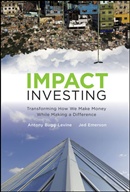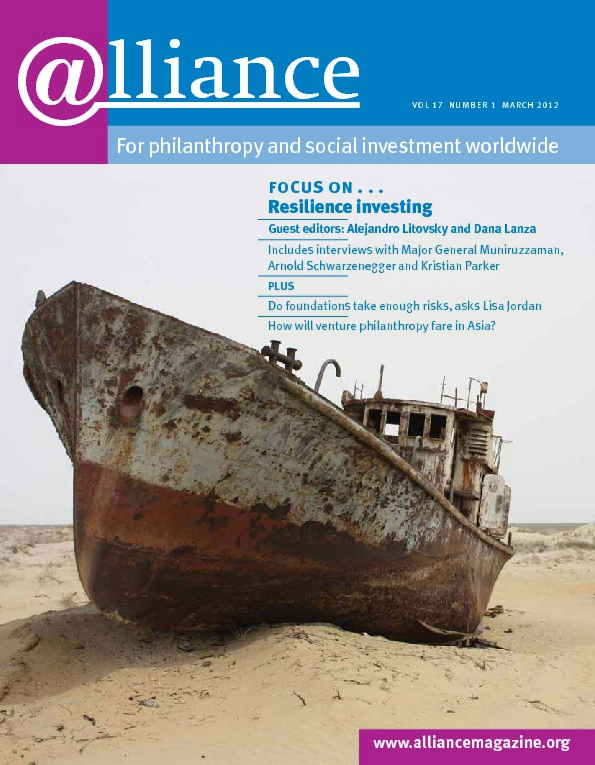 It all starts off like a fairy tale in which a number of noble, brave people have chosen to invest their money and lives for the betterment of humanity. For a moment, you are tempted to believe that you have embarked on yet another preaching of the end of capitalism. But the wake-up call is just around the corner. What follows is a razor-sharp analysis of the impact investing space, its origins and objectives, and its current and future challenges. Unlike many other works that focus on the trade-off between financial return and social impact, Jed Emerson and Antony Bugg-Levine illustrate, in a very compelling way, how blended value can generate wealth beyond the ill-designed concept of an impervious dividing line between financial return and social impact.
It all starts off like a fairy tale in which a number of noble, brave people have chosen to invest their money and lives for the betterment of humanity. For a moment, you are tempted to believe that you have embarked on yet another preaching of the end of capitalism. But the wake-up call is just around the corner. What follows is a razor-sharp analysis of the impact investing space, its origins and objectives, and its current and future challenges. Unlike many other works that focus on the trade-off between financial return and social impact, Jed Emerson and Antony Bugg-Levine illustrate, in a very compelling way, how blended value can generate wealth beyond the ill-designed concept of an impervious dividing line between financial return and social impact.
The authors focus on the question of what it takes for impact investing to succeed, defining impact investing as part of a systemic change – which itself requires systemic change. It shows that impact defenders need to accept the legitimacy of financial profit in impact investing in order to maximize social impact. Impact achieved through philanthropy may be perceived as more ‘noble’ but it falls short of the impact that for-profit investing can achieve through scale. To the for-profit investor, impact may appear as constraining the pursuit of maximum financial return. However, the authors provide delightful evidence for areas in which social impact can become a catalyst for financial return rather than an obstacle.
For impact investing to grow to scale, the authors convincingly argue that policymakers need to allow social enterprises to integrate social impact into true for-profit business models. The arguments put forward suggest that if social enterprises were to take over a large portion of public services, prejudice against for-profit investment in social enterprise would disappear. Such a course of action would not only preserve public spending power; it would increase efficiency and cure cases of state failure.
The book rigorously demonstrates the benefits that all stakeholders can draw from a flourishing impact investing market, and what role governments and regulators can play in creating a viable framework for this emerging industry. On many fronts, impact investing collides, and will continue to collide, with preconceived opinions about how financial markets ought to function. The financial crisis since 2008 has demonstrated unambiguously, however, that we cannot rely on those assumptions any longer.
In contrast to traditional financial theory, blended value maximizes the value of an investment for society without necessarily compromising either financial return or social impact. While pursuing blended value therefore appears to be a powerful alternative, it also requires radical change. First of all, we need to realize that the pursuit of social objectives can no longer be left solely to the limited resources of charities and philanthropic organizations and that even philanthropic efforts are best served if social issues that can be solved by market logic are addressed by the for-profit space.
Such a change will also necessitate the formulation of impact objectives, efficiency in asset allocation to such impact objectives, and transparency in impact measurement and performance. It will require investment management skills that segregate impact investment managers from impact posers and investment products that bring the work of pioneers to mainstream and retail markets; and it will require collaboration that widens individuals’ sometimes egocentric perspective on their own achievements to a view of impact achievable through scale.
The required change is also about a new form of leadership. The authors demonstrate that the dividing line between for-profit and for-impact mentalities is not confined to financial markets: it is present everywhere – in policymaking, in the design of school and university programmes, in the operating models of service providers and intermediaries – and the writers repeatedly show what we lose by holding on to this ‘bifurcated world’.
Against this background, it is forgivable that the last two chapters on potential funding sources for impact investing read more like the charter of a religious movement. While that does not diminish the merits of Emerson and Bugg-Levine’s ideas, we should not succumb to the illusion that impact investing is a matter of belief: it is potentially the most powerful means we have in the pursuit of sustainability for our society.
Uli Grabenwarter is co-author of In search of gamma: an unconventional perspective on impact investing. Email u.grabenwarter@pt.lu
To order
http://www.wiley.com
Impact Investing: Transforming how we make money while making a difference
Antony Bugg-Levine and Jed Emerson Wiley £23.99/€28/$34.95
ISBN 9780470907214


Comments (0)